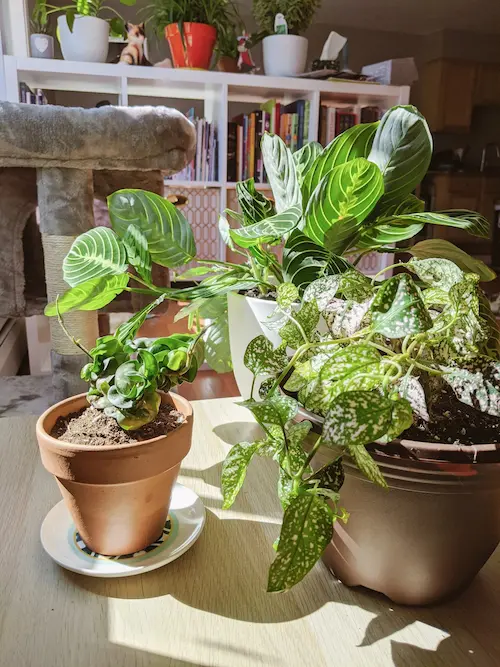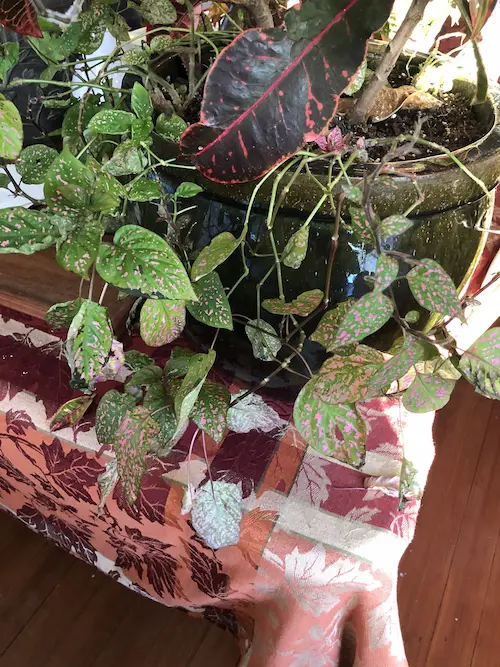How to Fix a Leggy Polka Dot Plant (Reasons & Solutions)
Written by LisaSmith
Jan 31 2023

Polka Dot plants can grow to 30-60 cm tall and 30 cm wide or even taller while potted plants are usually controlled within 10-15 cm tall. Leggy growth is one of the most common problems of the Polka Dot Plant. The stems growing too long will easily cause plant lodging, affecting their ornamental value. Leggy Polka Dot plants may also start to bloom purple flowers and usually die after they complete the flowering cycle. (Read More: Polka Dot Plant Flowering)
What is a Leggy Polka Dot Plant
Leggy growth often refers to that a plant grows longers stems than usual. Polka Dot Plants that become leggy or floppy tend to fall over and grow fewer leaves, creating an untidy spindly appearance.Polka Dot Plant leggy growth may be the result of too much nitrogen, low light situations and others. Follow the below parts to find out why polka dot plants become leggy and how to fix it.

Leggy Polka Dot Plant
Why Do Polka Dot Plants Become Leggy
Poor Light
Poor light is often the main reason for leggy Polka Dot plants. Under poor light conditions, the plant will grow longer stems quickly to try to get closer to light, resulting in thin, fragile stems. Polka Dot Plants have a natural tendency to grow toward the light because they need to capture the sun's energy by photosynthesis and store it in organic molecules. That's why you might notice your Polka Dot plant begins to reach somewhere towards the light source, sometimes to the point of bending completely sideways.Under poor light conditions, the leggy polka dot plant will also contain fewer leaves to save energy.
Read Next:
How Much Light Does Polka Dot Plant Require?
Lack of Water
If you’re inconsistent with watering and the soil mix of the Polka Dot Plant often dries out between watering days, it will cause leggy growth. Because lack of watering will also affect their photosynthesis, it prevents the plant from growing a strong stem and leafing out well.Read Next:
How Much & How Often to Water Polka Dot Plant?
Too Much Fertilizer
Although your Polka Dot plant does need nutrition to keep its leaves vibrant and luscious, too much fertilizer can cause limp, over quick growth but weak, leggy growth.In addition to leggy growth, other problems will also occur including leaves turning yellow, brown and even dying off.
Oversize Pot
If the pot is oversized, you may also end up with a leggy Polka Dot plant. polka dot plant life span is short and it is a fast-growing plant. It can grow to 30-60 cm tall and 30 cm wide or even taller while potted plants are usually controlled within 10-15 cm tall. The more room it has, the bigger and leggier it will get to fill the space as it can. You can prevent this to some extent with a little manual grooming and the proper fertilizing program.Natural Ageing
As the polka dot plant matures, the plant will get taller and leggier, which is a natural process. Meanwhile, it will usually begin to bloom and after that the plant usually goes dormant or dies. It’s generally difficult to stop your Polka Dot Plant flowering. However, you can remove flowers once they emerge to extend the plant life span and encourage foliar growth. After flowering, it is better to prepare for new Polka Dot plant propagation.Read Next:
How to Propagate Polka Dot Plant
Perfect Conditions
Plant growth is unpredictable in most cases. Polka Dot Plant legginess is often associated with perfect growing conditions which allow the plant to grow too much greener before it has adequate dimension and strength in stems and roots.Perfect conditions include proper temperature, regular watering, adequate light, and caring in all aspects.
Read Next:
How to Care for Polka Dot Plant

Leggy Polka Dot Plant
How to Fix a Leggy Polka Dot Plant from
Now you know the reasons for leggy polka dot plants, observe your plant, figure out the reason and take the corresponding action. Fortunately, it is not an urgent problem that will cause immediate danger to the plant. It only takes simple measures to solve the leggy growth.Pruning Polka Dot Plant
Fortunately, you can fix the leggy Polka Dot plant by pruning the plant during the growing season. To encourage fuller growth and maintain the desired shape and size, pinch back the stem tips periodically throughout the growing season in spring to summer. Also, pinch off any flower spikes that may develop. It is very simple to prune Polka Dot Plant. (Read More: How Long Do Polka Dot Plants Live)- Prepare a pair of clean pruners, hand gloves, rubbing alcohol
- Observe your polka dot plant and decide which parts you want to prune.
- Wear hand gloves and cut off the stem just above a set of leaves using your scissors.
- Spray rubbing alcohol on the wound to avoid bacterial infection
- Do not remove more than one-third of your plant’s growth.
Suitable Lighting
Another reason for the plant being too leggy is lack of light. The leaves of the plant tend to reach out for places with better lighting. To keep the colors of Polka Dot plant leaves bright and vibrant good light conditions are a must. Bright, indirect light will work best for Polka dot plant. Indoors, a spot near a window with morning sun will give your plant a good amount of healthy sunlight. Artificial light from grow lights can also work if you do not have a bright place you can put your plant in.Read Next:
How Much Light Does Polka Dot Plant Require?
Reduce Fertilizer
If you want your polka dot plants to look their best, they benefit from being fed once a month during the growing season, usually in spring or summer. Stop fertilizing in winter. After all, these guys are pretty quick growers. They finish their simple lifecycle in one year. A diluted liquid houseplant fertilizer is typically enough to do the job. You can also use a bit of compost for the extra nutrients.Too much fertilizer will cause leggy polka dot plant, in addtion to prune your plant, reduce fertilizer. You can just flush the soil with some distilled water, snip off the affected leaves and leggy stems and carry on from there.
Suitable Pot Size
If you think that your Polka Dot plant is in a oversized pot, re-pot it into a smaller pot. This will do your plant no harm and will help to keep its size small and compact. After repotting, the plant requires regular pruning as it grows to keep a compact shape.For a small to medium-sized plant, a pot of 4-6 inches (10-15 cm) in diameter should be fine with drainage holes to avoid waterlogging.
Regular Watering
The polka dot plant requires moist soil but is not soggy. Smaller-sized pots will dry out more quickly than larger-sized pots. If it dries out too much, it will begin to wilt, leggy growth and keel over. Water well when the top ½ to 1 inch of soil has dried out.Read Next:
How Much & How Often to Water Polka Dot Plant?
Cutting Propagation
For a failing leggy Polka Dot Plant, you can propagate a new plant from cuttings, making full use of the leggy stems. It is quite simpe and fast as you can create several new Polka Dot Plants just by taking a few small cuttings.Read Next:
How to Propagate Polka Dot Plant from Cuttings
Polka Dot Plant: Facts, Care & Propagation Guide
Polka Dot Plant Indoor Care
These plants primarily grow indoors, and if given the right conditions, their roots will expand rapidly. There is no point in having purple flowers if it causes the plant as a whole to suffer. These plants grow leggy where they have flowers. The flowers can be taken away by pinching them off because they take up energy that would otherwise go to the stem and leaves.
You must place polka-dot plants indoors in areas with ample filtered or indirect light. Put your lovely plant away from the sun's direct rays so the leaves don't get damaged. They can be grown outdoors in the shade if you use a large pot.
Did you know that polka dots can lose their green foliage color if they don't receive enough light? You may notice that the leaves have started to turn a light green color; this is a sign of inadequate light. This problem can be resolved by turning on indirect light for them.
Last but not least, I counsel you to periodically pinch off the stem to prevent it from growing leggy. this is the major concern on these plants.
Read More: Are Polka Dot Plants Toxic to Cats
Polka Dot Plant Problems
Use pesticide or neem oil to get rid of pests if your plant ever becomes infested with them. Don't overwater your plants because too much water will attract fungus, and always check the moisture of the water for fungal diseases with your finger.
Conclusion – Polka Dot Plant Leggy
Here, we've covered how to troubleshoot polka dot plants that are growing leggy, so if that happens to yours, hopefully this guide will help you fix the problem.
FAQs
How Do You Prune Leggy Plants?
Cutting back the stems and branches to just the leaf node will allow you to prune a plant that is growing too long. Make sure you cut as close to the main stem as you can or all the way to the bottom of the plant when completely removing large stems.
Can You Prune a Polka Dot Plant?
Your polka dot plant can be pruned, and this can keep it looking tidy and healthy. Pruning can be done at any time of the year, but it's best to avoid it in the winter because it can stunt growth.
How Do I Make My Polka Dot Plant Fuller?
Throughout the growing season of your polka dot plant, try pinching back the tip of the stem occasionally to promote fuller growth.
What Does It Mean When a Plant is Leggy?
Having a very long stem and few leaves on top, a plant is said to be leggy. Typically, plants that need to reach for light become leggy.
Latest Updated
- How Much Light Does a Polka Dot Plant Require?
- How to Water Polka Dot Plant (Frequency, Amount, Ways & Solution)
- How to Fix a Leggy Polka Dot Plant (Reasons & Solutions)
- Do Polka Dot Plant Flowers Bloom
- How to Propagate Polka Dot Plant (Ways & Steps)
- Polka Dot Plant (Hypoestes Phyllostachya Baker) Care & Propagation Guide
- Philodendron Golden Goddess vs Lemon Lime - Are They The Same
- Philodendron Lemon Lime vs Moonlight - Differences
- Lemon Lime Philodendron Care & Propagation Guide
- Why Does My Ponytail Palm Have Brown Tips - How to Fix
Popular Articles
- Winter maintenance of Antirrhinum Majus
- How to Grow Terminalia Mantaly Tree
- How to Grow and Care for Crossostephium Chinense
- How to grow Antirrhinum Majus in spring
- Peristeria Elata (Dove Orchid) Profile: Info & Care Guide
- Underwatered Snake Plant (Sansevieria Trifasciata) - Signs And How To Fix
- How to Care for Brazilian Jasmine Plant (Mandevilla Sanderi)
- Rosa Chinensis (China Rose): Plant Growing & Care Tips
- How to Grow & Care for Graptopetalum Purple Delight in Summer
- How to Care for Baby Sun Rose (Aptenia Cordifolia)